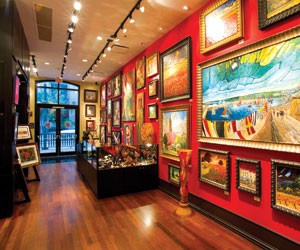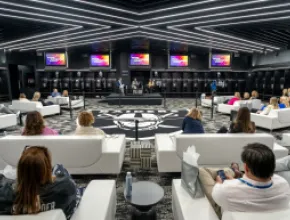While there are many factors that determine whether an executive retreat will achieve its goals, content and venue usually trump them all.
The venue really can enhance the small meeting/executive retreat experience, says Anne Thornley-Brown, president of Executive Oasis International, a Toronto-based consulting company that specializes in team building and executive retreats.
"For example, something like a desert survival simulation has been popular forever," she says. "You have people sit in a boardroom and engage in an exercise about what happens if you're lost in a desert and you try to draw parallels to business. Well, that's much more possible if you actually take your attendees to the desert. The environment is there and all of the senses are engaged, and people really do have the experience."
Of course, not every company can afford the luxury of taking a group of executives out to Dubai in order to take advantage of a desert's spectacular natural beauty (while hoping to get some serious business done at the same time). For such groups, spots in Florida still offer up fun in the sun and just as much to see as the desert's environs; the sights just are manmade attractions.
The Grand Bohemian Hotel, a boutique property in downtown Orlando, gets much of its meeting business from Florida-based companies that bring in customers and employees from across the country, according to David Friederich, the hotel's general manager.
And while groups meeting in Orlando certainly have opportunities to participate in those non-business related activities associated with the multiple theme parks outside of the downtown area, the Grand Bohemian offers meeting planners an experience that is "uniquely different" from other properties in the area, Friederich says.
"The fact that we're in downtown Orlando allows us to distinguish the meeting experience at the hotel by allowing us to personalize and elevate our service," he says. "However, we're not that far away from the theme parks."
The 247-room hotel caters to small corporate groups by emphasizing its "bohemian" style, particularly as it pertains to its meeting rooms.
Actually, as Friederich notes, the Grand Bohemian's meeting rooms are referred to as "galleries," each of which features original artwork from a particular artist. It gives each room a unique feel, according to Friederich.
"People immediately fall in love with the space," he says.
Feasts For The Eyes and Ears
Using music or art, as in the case of the Grand Bohemian, is a perfect way to create an environment that is conducive to conducting business, according to Thornley-Brown.
"Music, for example has been shown to stimulate the brain," she says. "You also want to have lots of natural light, because it will help your attendees keep their energy up."
Bruce Honig, president of Honig Idea Guides, a meeting facilitation, team building and training group located in San Francisco, agrees that light is a critical component in a meeting space.
"The job of a meeting facilitator is to create focus, and light does that," he says. "In addition, when I visualize a meeting or retreat, it involves attendees working together in groups or teams, and they need light to do that. A lot of larger hotels don't do well with lighting, so I actually prefer to facilitate in smaller places like boutique hotels."
The MileNorth, a 215-room boutique hotel in Chicago, tries to take advantage of its proximity to downtown Chicago while creating a businesslike environment for small corporate groups. It provides 3,000 feet of meeting space, which means the venue is intimate enough to ensure small groups get plenty of attention from hotel staff, says Heidi Edinger, CMP, CASE, director of sales and marketing.
"We're just a couple of blocks away from the lakefront, so the hotel provides the convenience and ability to get out to the attractions of Chicago very quickly," Edinger says. "But we also have the opportunity to keep people captive in a beautiful meeting space."
For example, the hotel's meeting rooms have floor-to-ceiling windows overlooking Chicago, Edinger says, which gives attendees a real sense of the downtown area while they're in a meeting environment that keeps them fresh, energized and attentive.PageBreak
Set Up For Success
In organizing a small meeting or corporate retreat it's always critical to understand the goals and objectives of the client, Executive Oasis' Thornley-Brown says. "What are the goals, what are the main takeaways? Ask yourself those questions and you come up with a theme that will really reinforce that."
If the retreat involves team-building exercises, Thornley-Brown advises, it's always useful to brief attendees beforehand so they understand the direct link between the activity and the business challenges and issues those activities are supposed to address.
"And once it's finished," she adds, "it's crucial to do a thorough debriefing so people can reflect on the experience, what they learned that made them successful as a team and how that translates to the business environment."
The meeting room itself should be set up for small group interaction, Thornley-Brown says, which means chairs should be set up in clusters or pods and not in rows. In addition, the room should be supplied with the props—such as video and posters—that can help support the theme of the meeting.
Honig likes rooms with plenty of wall space for illustrative purposes. "I also want the flexibility of having small tables and having enough room to move around," he says.
Brain Food
Food and beverage decisions can play a huge role in determining whether a small meeting/corporate retreat is successful or not.
"It's just like a car," Thornley-Brown says. "If you don't put gas in it, it won't run. It's the same idea with people, so it's really important to have healthy food accessible so if an attendee gets hungry, he can grab a healthy snack or beverage."
Honig says there are both advantages and disadvantages to having food and beverages in a meeting room.
"It is important to keep it flexible," he says. "If someone's hungry they do need to eat. On the other hand, you do have the distraction of people getting up and eating food."
It's also important to have meals served away from the meeting room.
"It's always best to get people out of that space," Honig says.
Always keep the attendees' preference in mind when planning meals, says independent meeting planner Arlene Sheff, CMP, of Seal Beach, Calif. For example, many of the attendees could be road warriors who are used to eating at functions or restaurants, and want to eat good, health-conscious food.
Give 'Em A Break
Sheff also advises that a break never be less than 15 minutes or more than 30 minutes long; the length should depend on the nature of the group.
"For example, if it's a group of salespeople you might want to extend the break to 30 minutes so that they can get something to eat and catch up on their sales calls," she says.
Of course, since attendees are probably going to be in that meeting space for much of the working day, the law of diminishing returns is bound to take hold unless the attendees have a chance of take a few breaks. The average adult learner has an attention span of 15 to 20 minutes, Thornley-Brown says.
"So I always propose that you start a meeting with a 15-or 20 minute sound bite and then have a group activity so attendees aren't sitting there impassively listening to some presentation."
Follow that up with a quick five-minute break and insert a full 15-minute break after another 45 minutes, and planners can keep attenders alert and attentive, she suggests.
Child's Play
While many groups can't afford to head to Napa Valley for a corporate retreat, much less fly to Dubai for a desert survival experience, there are less expensive options available to the enterprising planner.
Honig likes to take groups to San Francisco's Exploratorium, a hands-on science museum.
"When you meet there you get privacy, plenty of wall space and light, and it's also a place where you can have your attendees go out and play with the toys in a way that's appropriate for the meeting," he says.
And a new activity that Thornley-Brown has begun introducing in retreats is ice sculpting.
"It teaches attendees how to focus on things like shaping strategies," she says. "And chances are, nobody in the group has ever done it before, so it doesn't matter whether you're the CEO or a recent college graduate. It really levels the team."
Freelance writer Mike Bassett's short attention span would present a challenge to the even the most experienced executive retreat facilitator.






